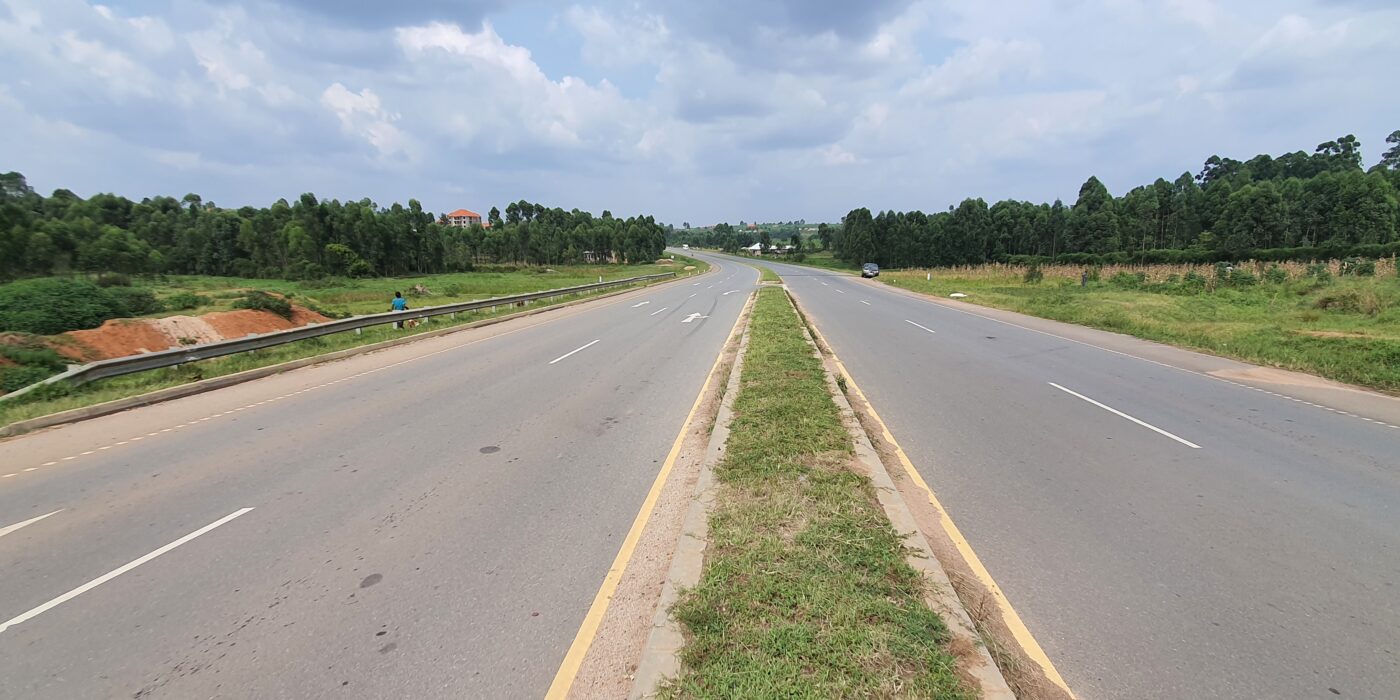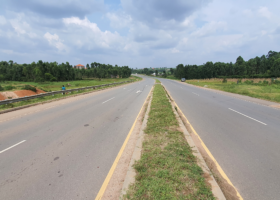
Overview
Over the past few decades, TRL Limited (known previously as the Transport Research Laboratory) has produced several guides and publications through research funded by the United Kingdom’s Department for International Development. The Overseas Road Note 31 (ORN 31): A Guide to the Design of Bitumen-surfaced Roads in Tropical and Sub-Tropical Countries, was one of the most notable guides produced through this funding. The last revision (4th Edition) of the ORN 31 was in 1993, but in 2022 the guide was revised to produce the 5th Edition, now titled Road Note 31: A Guide to the Design of Surfaced Roads in Tropical and Sub-Tropical Regions.
Publications with the same themes
Publications with the same study countries
Related news & events
Blog
News
PDF content (text-only)
Dissemination of the Structural Design of Surfaced Roads in Tropical and Sub-tropical Regions Integrating Climate Resilience into Road Networks Tropical regions Sub-Tropical regions Background Over the past few decades, TRL Limited (known previously as the Transport Research Laborator y) has produced several guides and publications through research funded by the United Kingdom’s Depar tment for International Development. The Overseas Road Note 31 (ORN 31): A Guide to the Design of Bitumen-surfaced Roads in Tropical and Sub-Tropical Countries , was one of the most notable guides produced through this funding. The last revision (4 th Edition) of the ORN 31 was in 1993, but in 2022 the guide was revised to produce the 5 th Edition, now titled Road Note 31: A Guide to the Design of Surfaced Roads in Tropical and Sub-Tropical Regions . Why you should use it The guide document is designed to be used in conjunction with countr y-specific design manuals. Despite it being a guidance document, it comes with its own flexible pavement design catalogue. This catalogue is based on empirical studies whose ranges have been extended using mechanistic analysis principles and verified using the structural number concept. Both the flexible pavement and rigid pavement designs have been tailored for use in tropical and sub-tropical regions of the world and especially for Low and Middle Income Countries (LICs and MICs). With regards to pavement design, tropical conditions significantly differ from those in a temperature climate. Tropical climates cause natural materials to weather in different ways, which has given rise to the need for road building materials of significantly different performance characteristics. Likewise, tropical environments mean that pavement materials are subjected to rapid wetting and rapid dr ying, and manufactured materials (such as bitumen and cement) are also subjected to frequently hot and wet (high rainfall intensities) environments, but over a narrower range compared to temperate climates. These climatic conditions present different challenges for pavement design purposes. The ORN 31 and other road notes under the series were developed for adapting road design to these conditions. What is new? The 4 th Edition of the Road Note was focussed on flexible pavements and did not include guidance or design of rigid (concrete pavements). Rigid pavements play an important role in combating climate change effects, therefore guidance on their design has been included in the 5 th Edition. Climate resilient sur facings, drainage and climate resilience have also been included in the 5 th Edition. Pavement rehabilitation is now of growing importance in LICs and MICs, so this has been integrated. Information on economic analysis inputs have been incorporated to remind engineers that any solution provided should be technically sound and economically justifiable. The 5 th Edition also comes with a number of spreadsheets to assist designers in completing designs quickly and easily. Lastly, the 5 th Edition is available as a digital document to enable timely updates and access to the most up-to-date revisions. This format also includes the means for users to send comments and questions about the contents, which allows issues to be clarified or revised easily and quickly. Summar y A summar y of the areas covered under these topics is provided as follows, but it is important to note that significant further content is covered in the 5 th Edition. 1 2 3 4 5 Whee l Crossfall 1 in 20 Camber or cross fall at least 1 in 40 Shoulder Running surfac eS ide drain 1 4 C L 2 3 5 7 6 Cros sfall 1 in 20 Camber or cross fall at least 1 in 40 Shoulder Running surfac eS ide drain 1 C L 2 8 5 6 (a) Separate shoulder material (b) Extended roadbase and sub-bas e Traffic In the computation of axle equivalence factors, the damage exponent (n) has for many years been taken as 4 to 4.5. Research in the last three decades shows that this value depends on the pavement structures used, with more suitable values ranging between 2 and 6. Consequently, the 5 th Edition now presents a range of values for use. A spreadsheet for determination of design cumulative equivalent standard axles from measured axles and average daily traffic (ADT), or from known vehicle equivalence factors (VEF) and ADT, has been provided in the 5 th Edition. Lane factor values to cater for lateral wander in determination of design traffic have also been included. The chapter now takes into account the effect of different axle configurations and tyre types (e.g. super-singles/wide-base) in the computation of design equivalent standard axles. Subgrade Accurate determination of subgrade strength is ver y important for pavement design. There has been confusion at sampling and design stage of projects regarding the location of the true subgrade. The 5 th Edition offers guidance on this issue. Improvement of problem soils (subgrades) has also been included. Moisture conditions for determining the design subgrade strength have been revised to take into account saturation that could occur as a result of climate change effects. It is no longer safe to design roads on the basis of subgrades characterised at optimum moisture content or ‘prevailing’ moisture content. Unbound Pavement Materials In the next few decades, use of recycled materials is expected to grow. It is probable that in some jurisdictions it may become mandator y to use recycled materials in new construction or rehabilitation projects. The 5 th Edition presents guidance on how recycled materials can be incorporated in pavement layers. Additionally, the use of large aggregate materials in upper pavement layers is currently being researched, which could provide many benefits such as a reduction in materials processing costs and high shear resistance (when ‘wedged’ with smaller particles). Guidance has been provided on these and other materials’ specifications. Hydraulically-bound Pavement Materials Previously, this was limited to lime, cement and pozzolan bound materials. In the 5th Edition, the use of Ground Granulated Blast Furnace Slag (GGBFS), and Hydraulic Road Binders have been added because of the benefit they provide in minimising shrinkage cracking. Emphasis has also been put on minimising shrinkage cracking in the construction methodology because this has been a major deterrent in the wide use of hydraulically stabilised pavement materials. A challenge to the use of hydraulically bound materials has been the need to keep the road untrafficked for a 3-7 days after construction. This presents a traffic management challenge. The 5th Edition now includes indices, which when satisfied, permit for opening to traffic immediately after construction. Bitumen-bound Materials This subject has been widened to include mitigation against aspects that have proved to be challenging to many countries in recent years, such as premature failures, cracking, and severe rutting. Guidance on the design of stone mastic asphalt and Enrobé à Module Élevé 2 (EME2), also known as high-modulus asphalt, has been included. Most importantly perhaps, options for climate resilient asphalt surfacings are provided. This includes the use of epoxy modified bituminous materials, prevention of embrittlement and ravelling, and other issues pertinent to providing climate resilient sur facings. MaterialDepth(MD) Road bed F oundatio n depth (FD) BASE SUBBAS E FOUNDA TION Capping layer, imported subgrade or in situ subgrad e SUB-FOUNDA TION Earthwork, cutting, in situ soil rock Ty r e Ty p e Axle Group Standard Axle Load (kN) Dual tyre axles Single Axle with Dual Tyres (SADT) 80 Tandem Axle with Dual Tyres (TADT) 13 5 Triaxle with Dual Tyres (TRDT) 182 Super-single (wide base) t yre axles Single Axle with Single Tyres (SAST) 58 Tandem A xle with Single Tyres (TAST) 98 Triaxle with Single Tyres (TRST) 132 Spray ba r for part B Nozzle Nozzle Spray bar for part A Road surface Curing agent mixed with bitumen (part B) Epoxy resi n(part A) 100m off the ground Drainage and Climate Resilience Drainage is interlinked with the provision of climate resilient pavements and this chapter is a significant upgrade of the Drainage chapter in the 4 th Edition. Surface and sub-surface drainage of pavements has been discussed in detail, including the mitigation of capillar y rise in pavements which would occur as a result of increased rainfall. Other climate resilience related aspects include prevention of washouts resulting from extreme rainfall events, drainage in problem soils, and adjusting hydrological designs to cater for increased rainfall. The use of Sustainable Drainage Systems has also been discussed. This is an important system to ensure that drainage from road pavements does not result in detrimental effects on the surrounding environment. Flexible Pavement Design Two major changes have been introduced in this area. The first is the change from a subgrade- based pavement design to a foundation-based pavement design. In the foundation-based design system, values of surface modulus on top of the native subgrade, or a combination of that and a suitable capping, are specified. These are then grouped into classes and the upper pavement layers are designed based on these classes. The surface modulus is measured using a Falling Weight Deflectometer (FWD) or Light Weight Deflectometer (LWD). This approach promotes the use of recycled pavement materials in lower pavement layers. However, equivalent subgrade classes and capping options are still provided for situations where a FWD or LWD may not be available and for use. The second change is that the design catalogues have been extended to cover design traffic of up to 80 million equivalent standard axles (MESA). The previous limit was 30 MESA. In so doing, the thickness of the asphalt layer has been limited to 125 mm in order to minimise initial construction costs. A spreadsheet has been provided that uses the traffic data and the subgrade data to generate several options of pavement structures for consideration by the design engineer. Rigid Pavement Design Guidance has been provided for the design of rigid (concrete) pavements because they are ver y important in providing climate-resilient infrastructure. The design method included in the 5 th Edition is based on the Australian method. This is because the method has been researched and customised to Australian conditions (some of which are tropical). Additionally, the Australian method provides for erosion-resilient design, since erosion could easily occur due to climate change effects. A spreadsheet has been provided that uses the traffic data and the subgrade data to generate options of sub-base and slab thicknesses for consideration by the design engineer. Mechanistic-Empirical pavement design is included in an Appendix and a worked example is provided within the guide. Rehabilitation Two broad areas are covered in this section. The first focuses on options that require only superficial inter ventions such as surface dressings, and regulating overlays or inlays to improve functionality. The second area presents three methods of overlay design to increase the structural capacity of the pavement. These include the Structural Number and Deflection Method, the Deflection and Rut Depth Method, and The Mechanistic Method. Economic Analysis Guidance is provided on key input parameters for economic analysis, economic analysis tools, decision criteria, and ranking and multi-criteria analysis. The pavement design engineer is required to conduct an economic analysis of all the pavement options generated from the flexible pavement design, rigid pavement design, and rehabilitation, then select an economically justifiable option. The economic analysis should be conducted by standard tools such as HDM-4. CarriagewaySubgrade Carriageway Sealed Unsealed Shoulder Shoulder Outer wheel trac k Outer wheel trac k Equilibrium moisture content Zone of seasonal moisture variatio n Zone of seasona l moisture variatio n Stable moisture Stable strength V ariabl e moisture V ariabl e Strengt h Variabl e moisture V ariabl e Strengt h This research was funded by UKAID through the UK Foreign, Commonwealth & Development Office under the High Volume Transport Applied Research Programme, managed by DT Global. hvtinfo@dt-global.com www.hvt.preview.consideredcreative.com @Transport_Links






